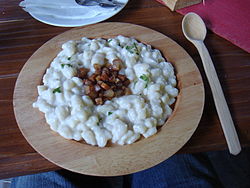| Bryndza | |
|---|---|
 | |
| Region | Central and Eastern Europe [1] |
| Source of milk | Sheep, goat, cow |
| Pasteurised | No |
| Texture | Depends on variety |
| Fat content | Depends on variety |
| Certification | Bryndza Podhalańska : PDO [2] Slovenská bryndza : PGI [3] |
| | |
Bryndza or brynza is a sheep milk cheese made across the countries in Central and Eastern Europe, most notably in Slovakia and Moldova. [1] Bryndza cheese is creamy white in appearance, known for its characteristic strong smell and taste. The cheese is white, tangy, crumbly and slightly moist. It has characteristic odor and flavor with a notable taste of butyric acid. The overall flavor sensation begins slightly mild, then goes strong and finally fades to a salty finish. Recipes differ slightly across countries.
Contents

Bryndza is an essential ingredient in preparing traditional Slovak dishes such as podplamenníky s bryndzou or bryndzové halušky .